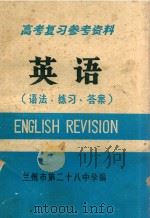《英语语法详解及练习》
| 作者 | (加拿大)Mary Ansell编 编者 |
|---|---|
| 出版 | 贵阳:贵州人民出版社 |
| 参考页数 | 452 |
| 出版时间 | 1994(求助前请核对) 目录预览 |
| ISBN号 | 7221031657 — 求助条款 |
| PDF编号 | 87519928(仅供预览,未存储实际文件) |
| 求助格式 | 扫描PDF(若分多册发行,每次仅能受理1册) |
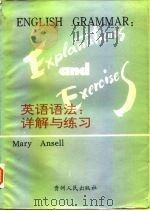
CHAPTER Ⅰ.The Simple Present of the Verb "to be"1
1.Grammar1
2.Verb Forms1
3.Uses of the Simple Present Tense2
4.The Simple Present of the Verb"to be"3
a.Affirmative Statements3
b.Questions4
c.Negative Statements4
d.Negative Questions4
e.Tag Questions5
Exercises6
CHAPTER Ⅱ.The Simple Present of Verbs Other than the Verb"to be"8
1.The Formation of the Simple Present8
a.The Simple Present of the Verb"to have"8
2.Spelling Rules for Adding"s"in the Third Person Singular9
a.Verbs Ending in"y"9
b.Verbs Ending in"o"9
c.Verbs Ending in"ch","s","sh","x",or"z"9
3.Pronunciation of the"es"Ending10
4.The Auxiliary"do"10
a.Questions11
b.Negative Statements11
c.Negative Questions12
d.Tag Questions12
Exercises13
CHAPTER Ⅲ.The Present Continuous16
1.Uses of the Present Continuous16
2.Formation of the Present Continuous16
3.Spelling Rules for the Formation of the Present Participle16
a.Verbs Ending in a Silent"e"16
b.Verbs Ending in"ie"17
c.One-Syllable Verbs Ending in a Single Consonant Preceded by a Single Vowel17
d.Verbs of More Than One Syll able Which End in a Single Consonant Preceded by a Single Vowel19
4.Questions and Negative Statements20
a.Questions21
b.Negative Statements21
c.Negative Questions21
d.Tag Questions21
5.Compari son of the Uses of the Simpl e Present and Present Continuous21
Exercises22
CHAPTER Ⅳ.The Present Perfect and the Present Perfect Continuous25
1.Use of the Present Perfect25
2.Formation of the Present Perfect-Regular Verbs25
3.Spelling Rules for Adding"ed"to Form the Past Participle26
a.Verbs Ending in a Sil ent"e"26
b.Verbs Ending in"y"26
c.Verbs Endingin a Single Consonant Preceded by a Single Vowel27
4.Pronunciation of the"ed"Ending28
5.Formation of the Present Perfect-Irregular Verbs29
6.Questions and Negative Statements29
a.Questions29
b.Negati ve Statements30
c.Negative Questions30
d.Tag Questions30
7.The Present Perfect Continuous31
a.Use31
b.Formation31
c.Questions and Negative Statements31
Exercises33
CHAPTER Ⅴ.The Simple Past37
1.Uses of the Simple Past37
2.Formation of the Simple Past37
a.The Verb"to be"37
ⅰ.Questions and Negative Statements37
b.Other Verbs38
ⅰ.Questions and Negative Statements39
3.The Simple Past of"to use"Followed by an Infinitive41
Exercises42
CHAPTER Ⅵ.The Past Continuous,the Past Perfect,and the Past Perfect Continuous45
1.Summary of the Uses of the English Tenses45
2.The Past Continuous45
a.Use45
b.Formation46
c.Questions and Negative Statements46
3.The Past Perfect47
a.Use47
b.Formation47
c.Questions and Negative Statements48
4.The Past Perfect Continuous49
a.Use49
b.Formation49
c.Questions and Negative Statements49
5.Summary of the Formati on of the English Present and Past Tenses50
6.Emphatic Statements51
Exercises53
CHAPTER Ⅶ.The Future Tenses58
1.The Simple Future58
a.Use58
b.Formation58
c.Questions and Negative Statements59
2.The Conjugation Expressing Determintion and Compulsion60
3.The Present Continuous of"to go"Followed by an Infinitive61
4.The Future Continuous61
a.Use61
b Formation62
c.Questions and Negative Statements62
5.The Future Perfect63
a.Use63
b.Formation63
c.Questions and Negative Statements63
6.The Future Perfect Continuous64
a.Use64
b.Formation64
c.Questions and Negative Statements65
7.Summary or the Formation of the English Future Tenses66
8.Clauses66
a.Coordinate Clauses66
b.Subordinate Clauses67
c.The Past Perfect and the Simple Past67
d.The Use of the Present in Subordinate Clause to Express Future Actions69
Exercises69
CHAPTER Ⅷ.Conjugations With the Auxiliary"Would"75
1.Uses of the Auxniliary"Wouwld"75
2.Formtion of Conjugations with the Auxiliary"Would"75
a.The Simple Conjugation With the Auxiliaty"Would"75
b.The Continuous Conjugation with the Auxiliary"Would"77
c.The Perfect Conjugation with the Auxiliary"Would"77
d.The Perfect Continuous Conjugation with the Auxiliary"Would"78
3.Summary of the Formation of the Conjugations with the Auxiliary"Would"80
4.The"Future in the Past"80
Exercises82
CHAPTER Ⅸ.The Subjunctive88
1.Uses of the Subjunctive88
2.Formation of the Subjunctive88
3.Formal Commands and Tequests92
4.Wishes92
a.An Earlier Time93
b.The Same Time93
c.A Later Time93
d.Summary of the Forms of the Verb Usedin the Subordinate Clauses of Wishes94
e.Use of the Auxil iary "Could" in Expressing Wishes94
5.Conditions Which are False or Improbable94
a.Forms of the Verb Used in the Main Clause95
ⅰ.Actions Pertaining to the Present or the Future95
ⅱ.Actions Pertaining to the Past96
ⅲ.Summary of the Forms of the Verb Used in the Main Clauses of Statements Containing False or Improbable Conditions96
ⅳ.Use of the Auxiliary "Could" in Statements Containing False or Improbable Conditions96
b.Forms of the Subjunctive Usedin the Subordinate Clause97
ⅰ.Conditions Pertaining to the Present or the Future97
ⅱ.Conditions Pertaining to the Past98
ⅲ.Summary of the Forms of the Subjunctive Used in Subordinate Clauses Expressing False or Improbable Conditions98
c.Changing a Statement Containing a Probable Condition into a Statement Containing an Improbable Condition98
6.The Imperative Mood99
Exercises100
CHAPTER Ⅹ.Modal Verbs107
1.Formation of the Modal Conjugations107
a.Questions108
b.Negative Statements108
c.Negative Questions109
d.Tag Questions109
2.Rel ationships Among the Modal Auxiliaries109
3."Can"and"Could"110
4."May","Might",and"Must"111
5."Should"112
6.Expressions Which are Synonymous with the Modal Auxiliaries112
a.The Pronunciation of"have to"113
7.The Use of Auxiliaries in Tag Questions,Short Answers,and Ellipsis114
a.Negative Tag Questions114
b.Affirmative Tag Questions114
c.Short Answers115
d.Ellipsis115
Exercises118
CHAPTER Ⅺ.Transitive and Intransitive Verbs125
1.Direct Objects125
2."Lay"and"Lie","Raise"and"Rise",and"Set"and"Sit"125
a."To Lay"and"To Lie"126
b."To Raise"and"To Rise"126
c."To Set"and"To Sit"127
3.Indirect Objects127
Exercises129
CHAPTER Ⅻ.The Passive Voice133
1.Use of the Passive Voice133
2.Formation of the Indicative Mood of the Passive Voice133
a.The Simple Present Indicative133
b.The Other Indicative Tenses134
c.Summary of the Formation of the Indicative Tenses of the Passive Voice136
3.Questions and Negative Statements137
a.Questions137
b.Negative Statements137
c.Negative Questions137
4.Changing the Voice of a Verb138
5.Changing the Voice of a Verb while Preserving the Meaning of a Sentence138
a.Changing the Verb from the Active Voice to the Passive Voice138
b.Changing the Verb from the Passive Voice to the Active Voice139
c.Changing the Voice of a Verb which takes both a Direct Object and an Indirect Object140
6.The Subjunctive Mood of the Passive Voice141
a.Use of the Simple Present Subjunctive142
b.Use of the Past Forms of the Subjunctive143
Exercises144
CHAPTER ⅩⅢ.Nouns-The Formation of Plurals148
1.Proper Nouns148
2.Countable Nouns148
3.The Formation of Plurals148
a.Nouns Ending in"ch","s","sh","x",or"z"149
b.Nouns Ending in"y"149
c.Plurals of Proper Nouns150
d.Nouns Ending in"f"or"fe"150
e.Nouns Ending in"o"151
f.Foreign Words152
g.Hyphenated Nouns152
h.Number's and Letters153
i.Irregular Plurals153
Exercises154
CHAPTER ⅩⅣ.Singular Countable Nouns158
1.The Use of Determiners with Singul ar Countable Nouns158
2."A"and"An"158
3.The Use of"A"and"An"Before Singul ar Countable Nouns159
a.A Weakened Form of"One"159
b.Naming a Profession159
c.Making a General Statement160
d.Referring to Something Not Mentioned Before160
e."A"or"An"with the Meaning of"Per"160
4.The Use of"The"Before Singul ar Countable Nouns160
a.Referring to Something Mentioned Before160
b.Referring to Something Unique161
c.Referring to Something Whenitis Considered Obvious What is Meant161
d.Referring to Something as a Class161
Exercises162
CHAPTER ⅩⅤ.Plural Countable Nouns164
1.The Absence of a Determiner Before Plural Countable Nouns164
a.Making a General Statement164
b.Referring to Something Not Mentioned Before164
c.Naming a Profession164
2.The Use of "The" Before Pl ural Countabl e Nouns165
a.Referring to Something Mentioned Before165
b.Referring to Something Whenitis Considered Obvious What is Meant165
c.Names of Nationalities165
d.Adjectives Referring to Classes of People166
3.The Use of"The"with Proper Nouns166
a.Names of People166
b.Names of Places167
4.Nouns Used Only in the Plural168
Exercises169
CHAPTER ⅩⅥ.Uncountabl e Nouns173
1.The Absence of a Determiner Before Uncountable Nouns173
a.Making a General Statement173
b.Referring to Something Not Mentioned Before173
2.The Use of"The"Before Uncountable Nouns174
a.Referring to Something Mentioned Before174
b.Referring to Something When it is Considered Obvious What is Meant174
3.The Use of Uncountabl e Nouns to Refer to Individual Things175
4.Nouns Which Can be Either Countable or Uncountable176
a.Differencesin Meaning176
b.Referring to a Type of Something176
c.Referring to Places Used for Specific Activities176
d.Names of Meals177
5.Infinitives Usedin the Place of Nouns177
6.Gerunds177
7.Specific Verbs Followed by Infinitives and Gerunds178
a.Verbs Followed by Infinitives178
b.Verbs Followed by Either Infinitives or Gerunds178
c.Verbs Followed by Gerunds179
Exercises180
CHAPTER ⅩⅦ.Nouns Indicating Possession and Compound Subjects183
1.Waysin Which Possession is Indicated183
a.The Ending's183
b.The Ending s'183
c.Phrases Beginning with"of"184
d.Two Consecutive Nouns184
2.Agreement of Verbs wi th Collective Nouns and Compound Subjects184
a.Collective Nouns185
b.Amounts Considered as a Whole185
c.Compound Subjects185
ⅰ.Compound Subjects with"And"185
ⅱ.Compound Subjects with"Or"or"Nor"186
d.Nouns Followed by Descriptive Phrases187
Exercises188
CHAPTER ⅩⅧ.Personal Pronouns192
1.The Subjective Case192
2.Agreement of Personal Pronouns with Their Antecedents193
a.Male and Female Antecedents193
b.Singular and Plural Antecedents193
c.Human and Non-Human Antecedents194
3.Special Uses of "It"195
4.The Objective Case196
5.Possessive Personal Pronouns198
a.Possessive Adjectives198
ⅰ.Possessive Adjectives Used with Gerunds199
b.Possessive Pronouns199
6.Reflexive Pronouns200
Exercises202
CHAPTER ⅩⅨ.Other Pronouns211
1.Indefinite Pronouns211
a.The Use of"One"in General Statements212
2.Reciprocal Pronouns213
3.Demonstrative Pronouns213
4.Interrogative Pronouns214
a.Direct Questions215
b.The Pronoun"Who"215
ⅰ."Who"215
ⅱ."Whom"216
ⅲ."Whose"216
c."What"and"Which"216
d.Indirect Questions217
ⅰ.Interrogative Word as the Subject217
ⅱ.Interrogative Word as the Object of a Verb or Preposition218
ⅲ.The Verb"to be"218
5.Relative Pronouns221
a.Defining and Non-defining Relative Clauses221
ⅰ.Non-defining Relative Clauses221
ⅱ.Defining Relative Clauses221
b."That"222
c."Which"222
d."Who","Whom",and"Whose"222
e.Comparison of the Use of"That","Which",and"Who"223
f.Other Relative Pronouns224
Exercises225
CHAPTER ⅩⅩ.Determiners234
1.Determiners Used to Refer to Groups of Two Persons or Things238
2.Determiners Used as Singul ar Pronouns240
3.The Use of"No","None",and "Not"241
4.The Use of"Some"and"Any"242
5.The Use of"Another","Other","Others",and"Else"244
6.The Use of"Only"245
7.The Use of"Few","Little",and "Several"246
8.The Expressions"Such...That","So...That",and"Too"246
a."Such...That"246
b."So...That"247
c."Too"248
Exercises249
CHAPTER ⅩⅪ.Adjectives-Position in a Sentence254
1.Proper Adjectives254
2.Attri butive Adjectives255
a.Order of Attributive Adjectives255
ⅰ.Determiners256
ⅱ.General Descri ptive Adjectives258
ⅲ.Adjectives Indicating Color259
ⅳ.Adjectives Indicating Materials260
ⅴ.The Position of Proper Adjectives260
ⅵ.Defining Adjectives261
ⅶ.Ordinal Adjectives262
b.Punctuation Used with Attri butive Adjectives263
c.Stress Used with Attri butive Adjectives264
ⅰ.Adjectives Indicating Materials264
ⅱ.Defining Adjectives Indicating Location or Time264
ⅲ.Defining Adjectives Indicating Purpose265
3.Predicate Adjectives265
a.Attributive Adjectives Which Can be Used as Predicate Adjectives265
ⅰ.Order266
ⅱ.Punctuation267
b.Adjectives Which Can be Used Only as Predicate Adjectives267
c.Linking Verbs268
4.Interpol ated Adjectives269
5.Adjectival Phrases and Clauses270
6.Participles Used as Adjectives270
a.Present Participles271
b.Past Participles271
c.Dangling Participles271
d.Past Participles which Follow the Verb"to be"273
Exercises274
CHAPTER ⅩⅫ.Adjectives-Comparison:Part Ⅰ283
1.Positive Forms of Adjectives Preceded and Followed by"As"283
a.The Positive Form Combined with a Noun284
b.The Use of Ellipsis285
c.The Use of the Subjective Case285
2.Comparative and Superlative Forms of Adjectives Which Use Endings286
a.Comparative Forms of Adjectives Which Use Endings286
ⅰ.Spelling Rules287
ⅱ.Irregul ar Adjectives288
ⅲ.The Comparative Form Followed by"Than"288
ⅳ.The Comparative Form Followed by a Noun,Followed by"Than"289
ⅴ.The Use of Ellipsis289
ⅵ.The Use of the Subjective Case290
ⅶ.Progressi ve Comparisons290
b.Superl ative Forms of Adjecti ves Which Use Endings291
ⅰ.Spelling Rules291
ⅱ.Irregul ar Adjectives291
ⅲ.The Superl ative Form Preceded by"The"292
ⅳ.The Use of Ellipsis292
ⅴ.The Comparison of One of More Things With a Group293
Exercises294
CHAPTER ⅩⅩⅢ.Adjectives-Comparison:Part Ⅱ301
1.Comparative and Superlative Forms of Adjectives Which do Not Use Endings301
a.Comparative Forms-The Use of"More"301
ⅰ.The Comparative Form Followed by"Than"301
ⅱ.Progressive Comparisons302
b.The Use of"Less"302
ⅰ.The Construction"Less...Than"303
ⅱ.The Construction"Not As...As"303
ⅲ.The Construction"Less and Less"304
c.Superlative Forms304
2.The Adjectives"Many","Much","Few",and"Little"Used to Compare Quantities305
a.The Use of"Many","Much","Few",and"Little"with Countable and Uncountable Nouns305
b.Synonyms for"Many"and"Much"306
c.Positive Forms Used in Comparisons307
d.Comparative Forms Used in Comparisons308
e.Superlative Forms Usedin Comparisons309
3.The Adjectives"Similar","Different",and"Same"Usedin Comparisons309
4.Making Logical Comparisons311
Exercises312
CHAPTER ⅩⅩⅣ.Adverbs-Position in a Sentence319
1.Adverbs Which Modify Adjectives and Other Adverbs319
a.Intensifiers320
2.Adverbs Which Modify Verbs320
a.Adverbs of Frequency320
b.Adverbs of Time322
c.Adverbs of Manner323
d.Connecting Adverbs324
e.Adverb Phrases and Clauses of Purpose325
f.Adverbs of Location326
g.Negative Adverbs329
3.Interrogative Adverbs331
Exercises332
CHAPTER ⅩⅩⅤ.Adverbs of Manner and Adverbs Used in Comparisons333
1.Adverbs of Manner337
a.Spelling Rules for Adding"ly"337
ⅰ.Adjectives Ending in"ic"337
ⅱ.Adjectives Ending in"le"337
ⅲ.Adjectives Ending in"ll"338
ⅳ.Adjectives Ending in"ue"338
ⅴ.Adjectives Endingin"y"338
b.Adverbs Which Do Not Use the Ending"ly"339
c.The Di fferi ng Functi ons of Adjectives and Adverbs341
ⅰ.Adjectives Which Modify Nouns and Adverbs Which Modify Verbs341
ⅱ.Adjectives Which Modify Nouns and Adverbs Which Modifv Verbs341
ⅲ.Predicate Adjectives Which Modify the Subjects of Verbs and Adverbs Which Modify Verbs342
2.Adverbs Used in Comparisons343
a.The Formation of Comparative and Superlative Forms of Adverbs343
ⅰ.Adverbs Used With"More"and"Most"343
ⅱ.Adverbs Used With the Endings"er"and"est"343
ⅲ.Irregular Adverbs344
b.Positive Forms of Adverbs Used in Comparisons344
ⅰ.The Construction With"As...As"344
ⅱ.Ellipsis344
c.Comparative Forms of Adverbs Used in Comparisons344
ⅰ.The Construction With"Than"344
ⅱ.Progressive Comparisons345
ⅲ.The Construction With"Less and Less"345
ⅳ.The Construction With"The...,the..."346
d.Superlative Forms of Adverbs Used in Comparisons346
ⅰ.TheConstruction With"The"346
ⅱ.The Construction With"The Least"346
Exercises347
CHAPTER ⅩⅩⅥ.Prepositions352
1.The Meanings of Prepositions353
2.Idioms Beginning With Prepositions359
3.Nouns Followed by Prepositions367
4.Adjectives,and Verbs in the Passive Voice,Followed by Prepositions368
5.Verbs Followed by Prepositions371
Exercises373
CHAPTER ⅩⅩⅦ.Phrasal Verbs378
1.Phrasal Verbs Consisting of a Verb Followed by a Preposition378
a.The Position of the Object of the Preposition381
b.The Position of an Adverb of Manner Modifying the Verb381
c.Stress in Spoken English381
d.Expressions in Which the Verb Has an Object381
2.Phrasal Verbs Consisting of a Verb Followed by an Adverb382
a.The Position of the Object of the Verb387
b.The Position of an Adverb of Manner Modifying the Verb387
c.Stress in Spoken English388
d.Ergative Verbs388
3.Distinguishing Between Verbs Followed by Prepositions and Verbs Followed by Adverbs389
4.Phrasal Verbs Consi sting of a Verb Followed by a Word Which Can Function Either as an Adverb or as a Preposition393
a.Expressions in Which the Verb Has an Object394
5.Phrasal Verbs Consi sting of a Verb Followed by an Adverb Followed by a Preposition395
a.Expressions in Which the Verb Has an Object396
Exercises397
CHAPTER ⅩⅩⅧ.Conjunctions403
1.Coordinate Conjunctions403
2.Correlative Conjunctions404
3.Subordinate Conjunctions404
4.Connecting Adverbs407
a.Stress and Punctuation408
b.Connecting Adverbs Used to Connect Sentences408
c.Position in a Clause408
d.Examples of Connecting Adverbs409
5.Parallel Construction410
Exercises412
Answers to the Exercises417
1994《英语语法详解及练习》由于是年代较久的资料都绝版了,几乎不可能购买到实物。如果大家为了学习确实需要,可向博主求助其电子版PDF文件(由(加拿大)Mary Ansell编 1994 贵阳:贵州人民出版社 出版的版本) 。对合法合规的求助,我会当即受理并将下载地址发送给你。
高度相关资料
-
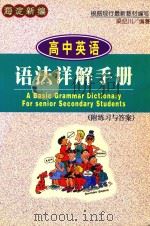
- 高中英语语法详解手册 附练习与答案
- 1999 西宁:青海人民出版社
-

- 英语语法详解 上
- 1997 昆明:云南科学技术出版社
-

- 英语阅读理解及练习
- 1982 开封:河南教育出版社
-

- 大学英语语法详解与精练
- 1999 西安:西安电子科技大学出版社
-

- 科技英语语法练习
- 1981 北京:测绘出版社
-
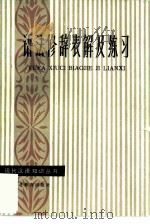
- 语法修辞表解及练习
- 1984 武汉:湖北教育出版社
-

- 科技英语语法练习与解答
- 1983 武汉:湖北科学技术出版社
-
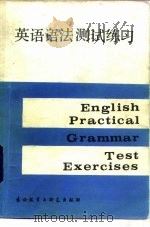
- 英语语法测试练习
- 1987 北京:外语教学与研究出版社
-

- 大学英语语法练习
- 1996 北京:中国致公出版社
-
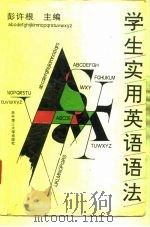
- 学生实用英语语法
- 1995 武汉:华中理工大学出版社
-
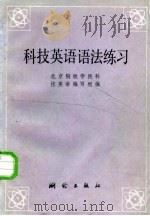
- 科技英语语法练习
- 1981 北京:测绘出版社
-
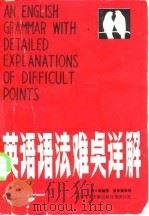
- 英语语法难点详解
- 1986 北京:科学技术文献出版社;重庆分社
-

- 英语中的一些特殊用法
- 1992 北京:商务印书馆
-

- 文言语法表解及练习
- 1986 北京:语文出版社
提示:百度云已更名为百度网盘(百度盘),天翼云盘、微盘下载地址……暂未提供。➥ PDF文字可复制化或转WORD
